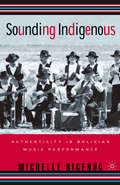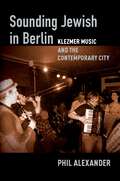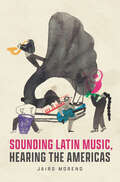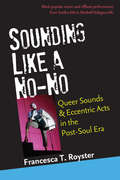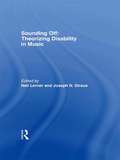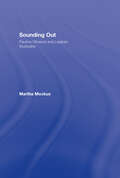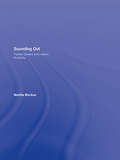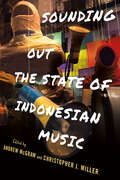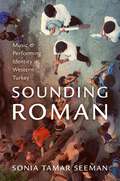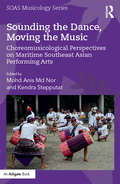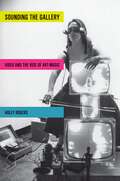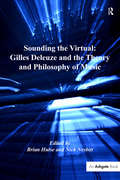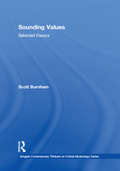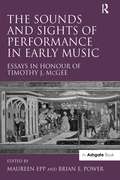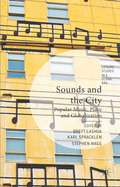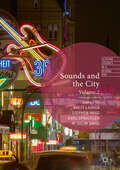- Table View
- List View
Sounding Indigenous: Authenticity in Bolivian Music Performance
by M. BigenhoSounding Indigenous explores the relations between music, people, and places through analysis of Bolivian music performances: by a non-governmental organization involved in musical activities, by a music performing ensemble, and by the people living in two rural areas of Potosi. Based on research conducted between 1993 and 1995, the book frames debates of Bolivian national and indigenous identities in terms of different attitudes people assume towards cultural and artistic authenticity. The book makes unique contributions through an emphasis on music as sensory experience, through its theorization of authenticity in relation to music, through its combined focus on different kinds of Bolivian music (indigenous, popular, avant-garde), through its combined focus on music performance and the Bolivian nation, and through its interpretation of local, national, and transnational fieldwork experiences.
Sounding Jewish in Berlin: Klezmer Music and the Contemporary City
by Phil AlexanderHow can a traditional music with little apparent historical connection to Berlin become a way of hearing and making sense of the bustling German capital in the twenty-first century? In Sounding Jewish in Berlin, author Phil Alexander explores the dialogue between the city's contemporary klezmer scene and the street-level creativity that has become a hallmark of Berlin's decidedly modern urbanity and cosmopolitanism. By tracing how klezmer music engages with the spaces and symbolic meanings of the city, Alexander sheds light on how this Eastern European Jewish folk music has become not just a product but also a producer of Berlin. This engaging study of Berlin's dynamic Yiddish music scene brings together ethnomusicology, cultural studies, and urban geography to evoke the sounds, atmospheres, and performance spaces through which klezmer musicians have built a lively set of musical networks in the city. Transcending a restrictive framework that considers this music solely in the context of troubled German-Jewish history and notions of guilt and absence, Alexander shows how Berlin's current klezmer communitya diverse group of Jewish and non-Jewish performersimaginatively blend the genre's traditional musical language with characteristically local tones to forge an adaptable and distinctively twenty-first-century version of klezmer. Ultimately, the music's vital presence in Berlin is powerful evidence that if traditional music is to remain audible amid the noise of the urban, it must become a meaningful part of that noise.
Sounding Jewish in Berlin: Klezmer Music and the Contemporary City
by Phil AlexanderHow can a traditional music with little apparent historical connection to Berlin become a way of hearing and making sense of the bustling German capital in the twenty-first century? In Sounding Jewish in Berlin, author Phil Alexander explores the dialogue between the city's contemporary klezmer scene and the street-level creativity that has become a hallmark of Berlin's decidedly modern urbanity and cosmopolitanism. By tracing how klezmer music engages with the spaces and symbolic meanings of the city, Alexander sheds light on how this Eastern European Jewish folk music has become not just a product but also a producer of Berlin. This engaging study of Berlin's dynamic Yiddish music scene brings together ethnomusicology, cultural studies, and urban geography to evoke the sounds, atmospheres, and performance spaces through which klezmer musicians have built a lively set of musical networks in the city. Transcending a restrictive framework that considers this music solely in the context of troubled German-Jewish history and notions of guilt and absence, Alexander shows how Berlin's current klezmer communitya diverse group of Jewish and non-Jewish performersimaginatively blend the genre's traditional musical language with characteristically local tones to forge an adaptable and distinctively twenty-first-century version of klezmer. Ultimately, the music's vital presence in Berlin is powerful evidence that if traditional music is to remain audible amid the noise of the urban, it must become a meaningful part of that noise.
Sounding Latin Music, Hearing the Americas (Big Issues in Music)
by Jairo MorenoHow is Latin American music heard, by whom, and why? Many in the United States believe Latin American musicians make “Latin music”—which carries with it a whole host of assumptions, definitions, and contradictions. In their own countries, these expatriate musicians might generate immense national pride or trigger suspicions of “national betrayals.” The making, sounding, and hearing of “Latin music” brings into being the complex array of concepts that constitute “Latin Americanism”—its fissures and paradoxes, but also its universal aspirations. Taking as its center musicians from or with declared roots in Latin America, Jairo Moreno presents us with an innovative analysis of how and why music emerges as a necessary but insufficient shorthand for defining and understanding Latin American, Latinx, and American experiences of modernity. This close look at the growth of music-making by Latin American and Spanish-speaking musicians in the United States at the turn of the twenty-first century reveals diverging understandings of music’s social and political possibilities for participation and belonging. Through the stories of musicians—Rubén Blades, Shakira, Arturo O’Farrill and the Afro-Latin Jazz Orchestra, and Miguel Zenón—Sounding Latin Music, Hearing the Americas traces how artists use music to produce worlds and senses of the world at the ever-transforming conjunction of Latin America and the United States.
Sounding Latin Music, Hearing the Americas (Big Issues in Music)
by Jairo MorenoHow is Latin American music heard, by whom, and why? Many in the United States believe Latin American musicians make “Latin music”—which carries with it a whole host of assumptions, definitions, and contradictions. In their own countries, these expatriate musicians might generate immense national pride or trigger suspicions of “national betrayals.” The making, sounding, and hearing of “Latin music” brings into being the complex array of concepts that constitute “Latin Americanism”—its fissures and paradoxes, but also its universal aspirations. Taking as its center musicians from or with declared roots in Latin America, Jairo Moreno presents us with an innovative analysis of how and why music emerges as a necessary but insufficient shorthand for defining and understanding Latin American, Latinx, and American experiences of modernity. This close look at the growth of music-making by Latin American and Spanish-speaking musicians in the United States at the turn of the twenty-first century reveals diverging understandings of music’s social and political possibilities for participation and belonging. Through the stories of musicians—Rubén Blades, Shakira, Arturo O’Farrill and the Afro-Latin Jazz Orchestra, and Miguel Zenón—Sounding Latin Music, Hearing the Americas traces how artists use music to produce worlds and senses of the world at the ever-transforming conjunction of Latin America and the United States.
Sounding Like a No-No: Queer Sounds and Eccentric Acts in the Post-Soul Era
by Francesca T RoysterSounding Like a No-No traces a rebellious spirit in post–civil rights black music by focusing on a range of offbeat, eccentric, queer, or slippery performances by leading musicians influenced by the cultural changes brought about by the civil rights, black nationalist, feminist, and LGBTQ movements, who through reinvention created a repertoire of performances that have left a lasting mark on popular music. The book's innovative readings of performers including Michael Jackson, Grace Jones, Stevie Wonder, Eartha Kitt, and Meshell Ndegeocello demonstrate how embodied sound and performance became a means for creativity, transgression, and social critique, a way to reclaim imaginative and corporeal freedom from the social death of slavery and its legacy of racism, to engender new sexualities and desires, to escape the sometimes constrictive codes of respectability and uplift from within the black community, and to make space for new futures for their listeners. The book's perspective on music as a form of black corporeality and identity, creativity, and political engagement will appeal to those in African American studies, popular music studies, queer theory, and black performance studies; general readers will welcome its engaging, accessible, and sometimes playful writing style, including elements of memoir.
Sounding Off: Theorizing Disability In Music
by Neil Lerner Joseph StrausDisability, understood as culturally stigmatized bodily difference (including physical and mental impairments of all kinds), is a pervasive and permanent aspect of the human condition. While the biology of bodily difference is the proper study for science and medicine, the meaning that we attach to bodily difference is the proper study of humanists. The interdisciplinary field of Disability Studies has recently emerged to theorize social and cultural constructions of the meaning of disability. Although there has been an astonishing outpouring of humanistic work in Disability Studies in the past ten years, there has been virtually no echo in musicology or music theory. Sounding Off: Theorizing Disability in Music is the first book-length work to focus on the historical and theoretical issues of music as it relates to disability. It shows that music, like literature and the other arts, simultaneously reflects and constructs cultural attitudes toward disability. Sounding Off: Theorizing Disability in Music promises to be a landmark study for scholars and students of music, disability, and culture.
Sounding Off: Theorizing Disability In Music
by Neil Lerner Joseph N. StrausDisability, understood as culturally stigmatized bodily difference (including physical and mental impairments of all kinds), is a pervasive and permanent aspect of the human condition. While the biology of bodily difference is the proper study for science and medicine, the meaning that we attach to bodily difference is the proper study of humanists. The interdisciplinary field of Disability Studies has recently emerged to theorize social and cultural constructions of the meaning of disability. Although there has been an astonishing outpouring of humanistic work in Disability Studies in the past ten years, there has been virtually no echo in musicology or music theory. Sounding Off: Theorizing Disability in Music is the first book-length work to focus on the historical and theoretical issues of music as it relates to disability. It shows that music, like literature and the other arts, simultaneously reflects and constructs cultural attitudes toward disability. Sounding Off: Theorizing Disability in Music promises to be a landmark study for scholars and students of music, disability, and culture.
Sounding Out: Pauline Oliveros And Lesbian Musicality
by Martha MockusSounding Out: Pauline Oliveros and Lesbian Musicality examines the musical career of the avant-garde composer, accordionist, whose radical innovations of the 1960s, 70s and 80s have redefined the aesthetic and formal parameters of American experimental music. While other scholars have studied Oliveros as a disciple of John Cage and a contemporary of composers Terry Riley, Lou Harrison, Gordon Mumma, and Robert Ashley, Sounding Out resituates Pauline Oliveros in a gynecentric network of feminist activists, writers, artists and musicians. This book shows how the women in Oliveros’s life were central sources of creative energy and exchange during a crucial moment in feminist and queer cultural history. Crafting a dynamic relationship between feminism and music-making, this book offers a queerly original analysis of Oliveros’s work as a musical form of feminist activism and argues for the productive role of experimental music in lesbian feminist theory. Sounding Out combines key elements of feminist theories of lesbian sexuality with Oliveros’s major compositions, performances, critical essays, and interviews. It also includes previously unpublished correspondence between Oliveros and Edith Guttierez, Jill Johnston, Annea Lockwood, Kate Millett, and Jane Rule.
Sounding Out: Pauline Oliveros and Lesbian Musicality
by Martha MockusSounding Out: Pauline Oliveros and Lesbian Musicality examines the musical career of the avant-garde composer, accordionist, whose radical innovations of the 1960s, 70s and 80s have redefined the aesthetic and formal parameters of American experimental music. While other scholars have studied Oliveros as a disciple of John Cage and a contemporary of composers Terry Riley, Lou Harrison, Gordon Mumma, and Robert Ashley, Sounding Out resituates Pauline Oliveros in a gynecentric network of feminist activists, writers, artists and musicians. This book shows how the women in Oliveros’s life were central sources of creative energy and exchange during a crucial moment in feminist and queer cultural history. Crafting a dynamic relationship between feminism and music-making, this book offers a queerly original analysis of Oliveros’s work as a musical form of feminist activism and argues for the productive role of experimental music in lesbian feminist theory. Sounding Out combines key elements of feminist theories of lesbian sexuality with Oliveros’s major compositions, performances, critical essays, and interviews. It also includes previously unpublished correspondence between Oliveros and Edith Guttierez, Jill Johnston, Annea Lockwood, Kate Millett, and Jane Rule.
Sounding Out the State of Indonesian Music (Cornell Modern Indonesia Project)
by Andrew McGraw Christopher J. MillerSounding Out the State of Indonesian Music showcases the breadth and complexity of the music of Indonesia. By bringing together chapters on the merging of Batak musical preferences and popular music aesthetics; the vernacular cosmopolitanism of a Balinese rock band; the burgeoning underground noise scene; the growing interest in kroncong in the United States; and what is included and excluded on Indonesian media, editors Andrew McGraw and Christopher J. Miller expand the scope of Indonesian music studies. Essays analyzing the perception of decline among gamelan musicians in Central Java; changes in performing arts patronage in Bali; how gamelan communities form between Bali and North America; and reflecting on the "refusion" of American mathcore and Balinese gamelan offer new perspectives on more familiar topics.Sounding Out the State of Indonesian Music calls for a new paradigm in popular music studies, grapples with the imperative to decolonialize, and recognizes the field's grounding in diverse forms of practice.
Sounding Roman: Representation and Performing Identity in Western Turkey
by Sonia Tamar SeemanHow do marginalized communities speak back to power when they are excluded from political processes and socially denigrated? In what ways do they use music to sound out their unique histories and empower themselves? How can we hear their voices behind stereotyped and exaggerated portrayals promoted by mainstream communities, record producers and government officials? Sounding Roman: Music and Performing Identity in Western Turkey explores these questions through a historically-grounded and ethnographic study of Turkish Roman ("Gypsies") from the Ottoman period up to the present. Drawing on extensive ethnographic fieldwork (1995 to the present), collected oral histories, historical documents of popular culture (recordings, images, song texts, theatrical scripts), legal and administrative documents, this book takes a hard look at historical processes by which Roman are stereotyped as and denigrated as "çingene"---a derogatory group name equivalent to the English term, "gypsy", and explores creative musical ways by which Roman have forged new musical forms as a means to create and assert new social identities. Sounding Roman presents detailed musical analysis of Turkish Roman musical genres and styles, set within social, historical and political contexts of musical performances. By moving from Byzantine and Ottoman social contexts, we witness the reciprocal construction of ethnic identity of both Roman and Turk through music in the 20th century. From neighborhood weddings held in the streets, informal music lessons, to recording studios and concert stages, the book traces the dynamic negotiation of social identity with new musical sounds. Through a detailed ethnography of Turkish Roman ("Gypsy") musical practices from the Ottoman period to the present, this work investigates the power of music to configure new social identities and pathways for political action, while testing the limits of cultural representation to effect meaningful social change.
SOUNDING ROMAN C: Representation and Performing Identity in Western Turkey
by Sonia Tamar SeemanHow do marginalized communities speak back to power when they are excluded from political processes and socially denigrated? In what ways do they use music to sound out their unique histories and empower themselves? How can we hear their voices behind stereotyped and exaggerated portrayals promoted by mainstream communities, record producers and government officials? Sounding Roman: Music and Performing Identity in Western Turkey explores these questions through a historically-grounded and ethnographic study of Turkish Roman ("Gypsies") from the Ottoman period up to the present. Drawing on extensive ethnographic fieldwork (1995 to the present), collected oral histories, historical documents of popular culture (recordings, images, song texts, theatrical scripts), legal and administrative documents, this book takes a hard look at historical processes by which Roman are stereotyped as and denigrated as "çingene"---a derogatory group name equivalent to the English term, "gypsy", and explores creative musical ways by which Roman have forged new musical forms as a means to create and assert new social identities. Sounding Roman presents detailed musical analysis of Turkish Roman musical genres and styles, set within social, historical and political contexts of musical performances. By moving from Byzantine and Ottoman social contexts, we witness the reciprocal construction of ethnic identity of both Roman and Turk through music in the 20th century. From neighborhood weddings held in the streets, informal music lessons, to recording studios and concert stages, the book traces the dynamic negotiation of social identity with new musical sounds. Through a detailed ethnography of Turkish Roman ("Gypsy") musical practices from the Ottoman period to the present, this work investigates the power of music to configure new social identities and pathways for political action, while testing the limits of cultural representation to effect meaningful social change.
Sounding the Dance, Moving the Music: Choreomusicological Perspectives on Maritime Southeast Asian Performing Arts (SOAS Studies in Music Series)
by Mohd Anis Nor Kendra StepputatPerforming arts in most parts of Maritime Southeast Asia are seen as an entity, where music and dance, sound and movement, acoustic and tactile elements intermingle and complement each other. Although this fact is widely known and referenced, most scholarly works in the performing arts so far have either focused on "music" or "dance" rather than treating the two in combination. The authors in this book look at both aspects in performance, moreover, they focus explicitly on the interrelation between the two, on both descriptive-analytical and metaphorical levels. The book includes diverse examples of regional performing art genres from Indonesia, Malaysia and the Philippines. All case studies are composed from the perspective of the relatively new approach and field of ethno-choreomusicology. This particular compilation gives an exemplary overview of various phenomena in movement-sound relations, and offers for the first time a thorough study of the phenomenon that is considered essential for the performing arts in Maritime Southeast Asia - the inseparability of movement and sound.
Sounding the Dance, Moving the Music: Choreomusicological Perspectives on Maritime Southeast Asian Performing Arts (SOAS Studies in Music Series)
by Kendra Stepputat Mohd Anis Md NorPerforming arts in most parts of Maritime Southeast Asia are seen as an entity, where music and dance, sound and movement, acoustic and tactile elements intermingle and complement each other. Although this fact is widely known and referenced, most scholarly works in the performing arts so far have either focused on "music" or "dance" rather than treating the two in combination. The authors in this book look at both aspects in performance, moreover, they focus explicitly on the interrelation between the two, on both descriptive-analytical and metaphorical levels. The book includes diverse examples of regional performing art genres from Indonesia, Malaysia and the Philippines. All case studies are composed from the perspective of the relatively new approach and field of ethno-choreomusicology. This particular compilation gives an exemplary overview of various phenomena in movement-sound relations, and offers for the first time a thorough study of the phenomenon that is considered essential for the performing arts in Maritime Southeast Asia - the inseparability of movement and sound.
Sounding the Gallery: Video and the Rise of Art-Music (Oxford Music / Media)
by Holly RogersBecoming commercially available in the mid 1960s, video quickly became integral to the intense experimentalism of New York City's music and art scenes. The medium was able to record image and sound at the same time, which allowed composers to visualize their music and artists to sound their images. But as well as creating unprecedented forms of audiovisuality, video work also producedinteractive spaces that questioned conventional habits of music and art consumption. This book explores the first decade of creative video work, focusing on the ways in which video technology was used to dissolve the boundaries between art and music.
Sounding the Gallery: Video and the Rise of Art-Music (Oxford Music / Media)
by Holly RogersBecoming commercially available in the mid 1960s, video quickly became integral to the intense experimentalism of New York City's music and art scenes. The medium was able to record image and sound at the same time, which allowed composers to visualize their music and artists to sound their images. But as well as creating unprecedented forms of audiovisuality, video work also producedinteractive spaces that questioned conventional habits of music and art consumption. This book explores the first decade of creative video work, focusing on the ways in which video technology was used to dissolve the boundaries between art and music.
Sounding the Virtual: Gilles Deleuze and the Theory and Philosophy of Music
by Nick NesbittIt is the contention of the editors and contributors of this volume that the work carried out by Gilles Deleuze, where rigorously applied, has the potential to cut through much of the intellectual sedimentation that has settled in the fields of music studies. Deleuze is a vigorous critic of the Western intellectual tradition, calling for a 'philosophy of difference', and, despite its ambitions, he is convinced that Western philosophy fails to truly grasp (or think) difference as such. It is argued that longstanding methods of conceptualizing music are vulnerable to Deleuze's critique. But, as Deleuze himself stresses, more important than merely critiquing established paradigms is developing ways to overcome them, and by using Deleuze's own concepts this collection aims to explore that possibility.
Sounding the Virtual: Gilles Deleuze and the Theory and Philosophy of Music
by Nick NesbittIt is the contention of the editors and contributors of this volume that the work carried out by Gilles Deleuze, where rigorously applied, has the potential to cut through much of the intellectual sedimentation that has settled in the fields of music studies. Deleuze is a vigorous critic of the Western intellectual tradition, calling for a 'philosophy of difference', and, despite its ambitions, he is convinced that Western philosophy fails to truly grasp (or think) difference as such. It is argued that longstanding methods of conceptualizing music are vulnerable to Deleuze's critique. But, as Deleuze himself stresses, more important than merely critiquing established paradigms is developing ways to overcome them, and by using Deleuze's own concepts this collection aims to explore that possibility.
Sounding Values: Selected Essays (Ashgate Contemporary Thinkers on Critical Musicology Series)
by Scott BurnhamFor several decades, Scott Burnham has sought to bring a ready ear and plenty of humanistic warmth to musicological inquiry. Sounding Values features eighteen of his essays on mainstream Western music, music theory, aesthetics and criticism. In these writings, Burnham listens for the values-aesthetic, ethical, intellectual-of those who have created influential discourse about music, while also listening for the values of the music for which that discourse has been generated. The first half of the volume confronts pressing issues of historical theory and aesthetics, including intellectual models of tonal theory, leading concepts of sonata form, translations of music into poetic meaning, and recent rifts and rapprochements between criticism and analysis. The essays in the second half can be read as a series of critical appreciations, engaging some of the most consequential reception tropes of the past two centuries: Haydn and humor, Mozart and beauty, Beethoven and the sublime, Schubert and memory.
Sounding Values: Selected Essays (Ashgate Contemporary Thinkers on Critical Musicology Series)
by Scott BurnhamFor several decades, Scott Burnham has sought to bring a ready ear and plenty of humanistic warmth to musicological inquiry. Sounding Values features eighteen of his essays on mainstream Western music, music theory, aesthetics and criticism. In these writings, Burnham listens for the values-aesthetic, ethical, intellectual-of those who have created influential discourse about music, while also listening for the values of the music for which that discourse has been generated. The first half of the volume confronts pressing issues of historical theory and aesthetics, including intellectual models of tonal theory, leading concepts of sonata form, translations of music into poetic meaning, and recent rifts and rapprochements between criticism and analysis. The essays in the second half can be read as a series of critical appreciations, engaging some of the most consequential reception tropes of the past two centuries: Haydn and humor, Mozart and beauty, Beethoven and the sublime, Schubert and memory.
The Sounds and Sights of Performance in Early Music: Essays in Honour of Timothy J. McGee
by Maureen Ep Brian E. PowerThe experience of music performance is always far more than the sum of its sounds, and evidence for playing and singing techniques is not only inscribed in music notation but can also be found in many other types of primary source materials. This volume of essays presents a cross-section of new research on performance issues in music of the Middle Ages and Renaissance. The subject is approached from a broad perspective, drawing on areas such as dance history, art history, music iconography and performance traditions from beyond Western Europe. In doing so, the volume continues some of the many lines of inquiry pursued by its dedicatee, Timothy J. McGee, over a lifetime of scholarship devoted to practical questions of playing and singing early music. Expanding the bases of inquiry to include various social, political, historical or aesthetic backgrounds both broadens our knowledge of the issues pertinent to early music performance and informs our understanding of other cultural activities within which music played an important role. The book is divided into two parts: 'Viewing the Evidence' in which visually based information is used to address particular questions of music performance; and 'Reconsidering Contexts' in which diplomatic, commercial and cultural connections to specific repertories or compositions are considered in detail. This book will be of value not only to specialists in early music but to all scholars of the Middle Ages and Renaissance whose interests intersect with the visual, aural and social aspects of music performance.
The Sounds and Sights of Performance in Early Music: Essays in Honour of Timothy J. McGee
by BrianE. PowerThe experience of music performance is always far more than the sum of its sounds, and evidence for playing and singing techniques is not only inscribed in music notation but can also be found in many other types of primary source materials. This volume of essays presents a cross-section of new research on performance issues in music of the Middle Ages and Renaissance. The subject is approached from a broad perspective, drawing on areas such as dance history, art history, music iconography and performance traditions from beyond Western Europe. In doing so, the volume continues some of the many lines of inquiry pursued by its dedicatee, Timothy J. McGee, over a lifetime of scholarship devoted to practical questions of playing and singing early music. Expanding the bases of inquiry to include various social, political, historical or aesthetic backgrounds both broadens our knowledge of the issues pertinent to early music performance and informs our understanding of other cultural activities within which music played an important role. The book is divided into two parts: 'Viewing the Evidence' in which visually based information is used to address particular questions of music performance; and 'Reconsidering Contexts' in which diplomatic, commercial and cultural connections to specific repertories or compositions are considered in detail. This book will be of value not only to specialists in early music but to all scholars of the Middle Ages and Renaissance whose interests intersect with the visual, aural and social aspects of music performance.
Sounds and the City: Popular Music, Place and Globalization (Leisure Studies in a Global Era)
by Stephen Wagg Karl Spracklen Brett LashuaThis book explores the ways in which Western-derived music connects with globalization, hybridity, consumerism and the flow of cultures. Both as local terrain and as global crossroads, cities remain fascinating spaces of cultural contestation and meaning-making via the composing, playing, recording and consumption of popular music.
Sounds and the City: Volume 2 (Leisure Studies in a Global Era)
by Stephen Wagg Karl Spracklen Brett Lashua M. Selim YavuzThis book draws from a rich history of scholarship about the relations between music and cities, and the global flows between music and urban experience. The contributions in this collection comment on the global city as a nexus of moving people, changing places, and shifting social relations, asking what popular music can tell us about cities, and vice versa. Since the publication of the first Sounds and the City volume, various movements, changes and shifts have amplified debates about globalization. From the waves of people migrating to Europe from the Syrian civil war and other conflict zones, to the 2016 “Brexit” vote to leave the European Union and American presidential election of Donald Trump. These, and other events, appear to have exposed an anti-globalist retreat toward isolationism and a backlash against multiculturalism that has been termed “post-globalization.” Amidst this, what of popular music? Does music offer renewed spaces and avenues for public protest, for collective action and resistance? What can the diverse histories, hybridities, and legacies of popular music tell us about the ever-changing relations of people and cities?
